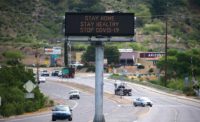
Los Angeles avoided "Carmageddon 2" on Interstate 405 on Sept. 30 and reached a milestone in an ambitious attempt to make over its transportation landscape. It is the busiest time ever for officials with the Los Angeles County Metropolitan Transportation Authority, or Metro, with several major projects ongoing. If a November ballot passes, they will be even busier.
"We are trying to transform Los Angeles out of the car culture," says K.N. Murthy, executive director of transit project delivery for Metro, which on Oct. 1 marked another milestone: It closed on a $549.5-million Transportation Infrastructure Finance and Innovation Act loan for the $1.7-billion, 8.5-mile, six-station extension of a light-rail line to Los Angeles International Airport.
Of an estimated $40 billion expected to result from Measure R, a half-cent sales-tax increase approved by voters in 2008, 35% is marked for a dozen major rail projects. One, a four-mile extension of a 14-mile bus rapid transit line from Canoga Park to Chatsworth, opened this summer. Officials say the three-year project was completed in half the anticipated time and will come in some $61 million under budget. Also, $735-million, 11.5-mile Metro Gold Line extension scheduled to finish in 2015 is on track, with an $18.6-million signature bridge nearly complete.
 |
| MURTHY |
Dan Kulka, a Kiewit spokesman, says demolition went as planned, except for a couple of bus-sized girder chunks that unexpectedly fell and landed on the 4-ft-thick dirt cushion below.
Hoe rams punched through the deck and chipped away at concrete. Workers used oxygen-acetylene torches to cut the steel rebar. Kulka says this demolition was more complex than last year's because it involved tearing down four columns instead of two. To avoid having columns fall onto a new bridge, crews chipped away from the top of the 80-ft-tall columns all the way down, like "eating a carrot."
Another Measure R-boosted project, the second phase of the Exposition light-rail line, is proceeding with military-like precision. Eager to minimize the many challenges that plagued the first phase, the joint venture of Skanska and Rados maintain a war room. Charts track project components from months ahead to a three-week time frame. Much of the 6.6-mile extension to Santa Monica will follow the median of a congested thoroughfare. "We will have to get a majority of the underground utilities out from under the tracks," says Brian Freund, the team's project manager.
To handle the unprecedented amount of work, Metro revamped its project management system two years ago, says Julie Owens, Metro senior project controls manager. Using an Ecosys-provided system, "we automated a lot of our jobs, so we can spend time on analysis and figure out how much we will be spending," she says. "One report used to take a week. Now it takes 15 minutes." The technology will help Metro avoid having to quadruple its construction staff, she adds.
It also will prepare Metro for even more work if Measure J passes next month. Measure J would extend the sales- tax increase by 30 years to 2069, allowing Metro to sell bonds and start work on seven transit projects and up to eight highway projects within the next five years, instead of the next 20. "It will be $80 billion worth of projects for a battle-tested organization," says Arthur Hadnett, vice president with Stantec Consulting, Metro's construction manager.
So far, the biggest highway component, the $1-billion widening of I-405, involved a 10-mile-long closure of the Sepulveda Pass so that design-build crews—led by Kiewit Infrastructure West under a $740-million contract—could tear down the remaining northern half of the 608-ft-long Mulholland Bridge. The two-day closure began on Sept. 29 and ended hours ahead of schedule on Sunday morning. .




Post a comment to this article
Report Abusive Comment